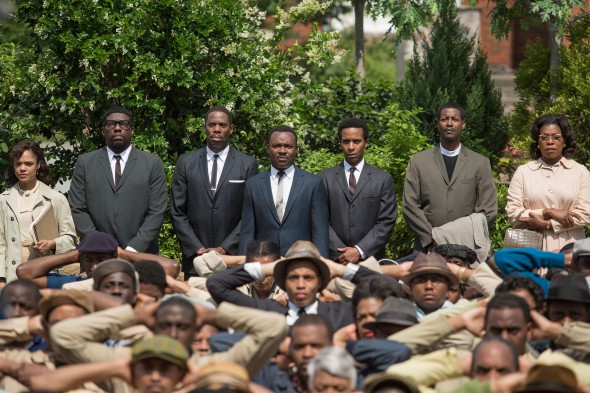‘Selma’ brings civil rights history to today’s headlines

A scene from “Selma.” L-R: Tessa Thompson (Diane Nash), Omar Dorsey (James Orange), Colman Domingo (Ralph Abernathy), David Oyelowo (Martin Luther King Jr.), André Holland (Andrew Young), Corey Reynolds (Rev. C.T. Vivian) and Lorraine Toussaint (Amelia Boynton). Paramount Pictures, Pathé and Harpo Films.
Watch “Selma” at a free private screening for UIC students, faculty and staff only, 5 p.m. Jan. 20 at Roosevelt Icon theater, sponsored by Campus Programs. RSVP required.
Although the actions Martin Luther King Jr. took to fight for civil rights happened in the ’60s, “Selma” is relevant to today’s headlines.
The film follows the legendary figure, played by David Oyelowo (“The Butler,” “Interstellar”), in a specific moment in history: the three Selma-to-Montgomery marches in 1965 Alabama.
“King had a huge epic life, but we just focused on Selma because I feel like it was a time that felt very cumulative for him,” said the film’s director, Ava DuVernay, in an interview for college media Dec. 4 in Chicago.
“Everything that he was, everything that he stood for, came to a head in Selma.”
Hundreds were involved in the peaceful protests, and the film doesn’t ignore them while exploring King’s personal and public struggles leading up to and during the marches.
Out of the marches came the 1965 Voting Rights Act — a monumental achievement during the civil rights movement and the film’s end point.
Not only is “Selma,” which opens widely Friday, the first big screen look at Dr. King, but it mimics the footage from recent protests and riots taking a stand against racism and police brutality across the country.
“We were aware that we were making a film about a particular time in history, and we wanted to make that time in history feel immediate, and vibrant,” Oyelowo said. “We were in a sense, trying to make sure that 1965 doesn’t feel so distant in the past.”
It turned out that it wasn’t. Shortly after wrapping the film, the Michael Brown tragedy happened in Ferguson, Missouri. Oyelowo recalls seeing the news images after the incident and calling DuVernay, asking, “Didn’t we just shoot this in the film?”
Then the Eric Garner video made headlines in New York City.
“Selma is now a reference for Ferguson because we are talking about strategy,” Oyelowo said. “We are talking about yet another community rallying around an injustice and that affecting the nation and the world.”
“Selma” is a visceral and emotional experience. From the beatings to the arm-in-arm marches, the film creates an emotional response. It’s a mix of beauty and tragedy that’s delivered through cinematography and story.
The film’s “musical tapestry” helps evoke power in the senses, said DuVernay, who said she paid close attention to the film’s musical character.
Music supervisor Morgan Rhodes, a radio DJ in LA and a longtime collaborator with DuVernay, found the lesser-known songs used in “Selma.”
“I didn’t want any hits from 1965,” DuVernay said. “None of the Supremes, none of the Temptations — the stuff that everyone knows.”
DuVernay told Rhodes to find her the B-sides, the music no one’s heard.
Listen for the song playing over the end credits — “Glory,” a song rapper and hip-hop artist Common wrote specifically for the film.
“The music in all of my films is something I pay a lot of attention to,” DuVernay said. “I feel like music is a character, and I love to use it as a filmmaking tool.”
